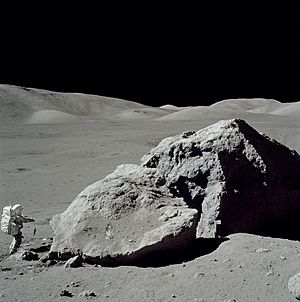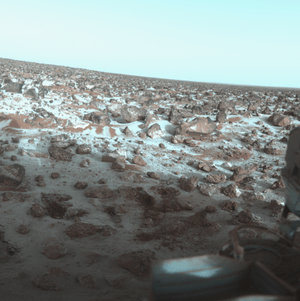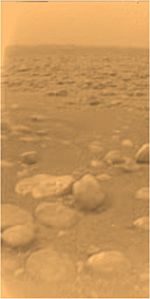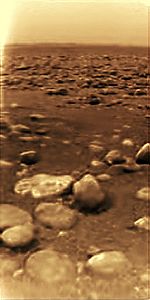Planetary geology facts for kids


Planetary geology, also called astrogeology, is the study of how planets, moons, asteroids, and comets are made. It looks at their rocks, landforms, and how they have changed over time. This field combines ideas from geology (Earth science) and astronomy (space science). Planetary geologists want to understand how these space objects formed and what they are like today.
Contents
What Do Planetary Geologists Do?
Planetary geologists are like space detectives! They use many tools to explore other worlds, including:
- Telescopes: To watch planets and moons from Earth.
- Spacecraft: To send probes and rovers to explore planets up close.
- Remote Sensing: Using cameras and other tools on spacecraft to take pictures and gather information from far away.
- Sample Analysis: Studying rocks and soil samples brought back from other planets, like the Moon.
- Computer Models: Creating computer simulations to understand how planets form and change.
What Are Planets Made Of?
Just like Earth, other planets are made of rocks, minerals, and metals. But the amounts of these materials can be very different!
- Rocks: Solid materials made of different minerals. Common rocks on Earth and other planets include basalt (a dark volcanic rock) and granite (a lighter rock).
- Minerals: Natural, solid substances with a specific chemical makeup and crystal shape. Examples are quartz, feldspar, and olivine.
- Metals: Elements like iron, nickel, and aluminum. They are good at carrying electricity and heat. Many planets have a core made mostly of iron.
- Ices: Frozen water, carbon dioxide, methane, or ammonia. Ices are common on planets and moons far from the Sun, where it is very cold.
How Do Planets Change?
Planets are always changing because of different geological processes. These processes include:
- Impact Cratering: This happens when asteroids or comets crash into a planet or moon. They create bowl-shaped holes called impact craters. The number and size of craters can tell us how old a surface is. For example, the Moon has many craters because it has no atmosphere to burn up incoming space rocks.
- Volcanism: This is when melted rock (magma) erupts onto the surface. Volcanoes can build mountains, flat plains, and other interesting features.
- Tectonics: This is the movement of a planet's outer layer, called the crust. On Earth, plate tectonics causes earthquakes, volcanoes, and mountain building. Other planets, like Mars and Venus, show signs of past tectonic activity.
- Erosion: This is the wearing away of a planet's surface by wind, water, or ice. Earth has a lot of erosion because of its atmosphere and oceans. Mars also shows signs of past water erosion, like dried-up riverbeds.
- Sedimentation: This is when sediments (like sand, silt, and clay) are dropped off by wind, water, or ice. Sedimentary rocks can form over time as these sediments are pressed and glued together.
Exploring Our Solar System's Planets
Let's take a quick trip around some planets and moons in our solar system to see what planetary geologists have found!
Mercury: The Speedy Planet
- What we know: Mercury is the smallest planet and closest to the Sun. It has a surface full of craters, much like the Moon. It also has a very thin atmosphere.
- Cool fact: Mercury has huge cliffs called scarps. These formed as the planet cooled down and shrank.
- Missions: Mariner 10 (1974-1975), MESSENGER (2011-2015), BepiColombo (still traveling there).
Venus: The Hot, Cloudy World
- What we know: Venus is similar in size to Earth. But it has a very thick atmosphere made mostly of carbon dioxide. This creates a super strong greenhouse effect, making Venus the hottest planet in our solar system.
- Cool fact: Venus has thousands of volcanoes, but no signs of moving tectonic plates like Earth.
- Missions: Venera program (1961-1984), Magellan (1990-1994), Venus Express (2006-2014).
Earth: Our Home Planet
- What we know: Earth is the only planet we know that has life. Its surface is always changing with plate tectonics, volcanoes, mountains, and oceans.
- Cool fact: Earth's atmosphere is mostly nitrogen and oxygen, which is vital for life.
- Missions: Many missions, including satellites, space stations, and rovers.
Mars: The Red Planet
- What we know: Mars is a cold, desert planet with a thin atmosphere. It shows signs of past water, like dried-up riverbeds, lakes, and maybe even oceans.
- Cool fact: Mars has the biggest volcano in the solar system, Olympus Mons. It also has a huge canyon system called Valles Marineris.
- Missions: Viking program (1975-1980), Mars Pathfinder (1997), Mars Exploration Rovers (Spirit and Opportunity, 2004-2018), Curiosity rover (2012-present), Perseverance rover (2021-present).
Jupiter: The Giant Gas Planet
- What we know: Jupiter is the largest planet in our solar system. It is a gas giant, meaning it is mostly made of hydrogen and helium.
- Cool fact: Jupiter has a huge storm called the Great Red Spot. It has been raging for at least 300 years!
- Missions: Pioneer program (1973-1974), Voyager program (1979), Galileo (1995-2003), Juno (2016-present).
Saturn: The Ringed Jewel
- What we know: Saturn is famous for its beautiful rings, which are made of ice and rock pieces. It is also a gas giant, like Jupiter.
- Cool fact: Saturn has many moons, including Titan. Titan has a thick atmosphere and lakes made of liquid methane.
- Missions: Pioneer 11 (1979), Voyager program (1980-1981), Cassini-Huygens (2004-2017).
Uranus: The Tilted Ice Giant
- What we know: Uranus is an ice giant. This means it is mostly made of icy materials like water, methane, and ammonia. It is tilted on its side, so its poles point towards the Sun.
- Cool fact: Uranus has faint rings and many moons.
- Missions: Voyager 2 (1986).
Neptune: The Windy Ice Giant
- What we know: Neptune is another ice giant, similar to Uranus. It has very strong winds and a dark spot, like Jupiter's Great Red Spot.
- Cool fact: Neptune has a large moon called Triton. Triton orbits in the opposite direction of Neptune's spin.
- Missions: Voyager 2 (1989).
Pluto: The Dwarf Planet
- What we know: Pluto is a dwarf planet found in the Kuiper Belt. This is a region beyond Neptune filled with icy objects. Pluto has a heart-shaped glacier made of nitrogen ice.
- Cool fact: Pluto has five moons, including Charon, which is almost half the size of Pluto!
- Missions: New Horizons (2015).
Why Is Planetary Geology Important?
Planetary geology helps us understand many things:
- The beginning and changes of the solar system: By studying other planets, we can learn how our solar system formed and how it has changed.
- The chance for life beyond Earth: By studying conditions on other planets, we can guess if they could support life.
- The future of Earth: By studying how other planets have changed, we can better understand what might affect Earth in the future.
See also
 In Spanish: Astrogeología para niños
In Spanish: Astrogeología para niños



